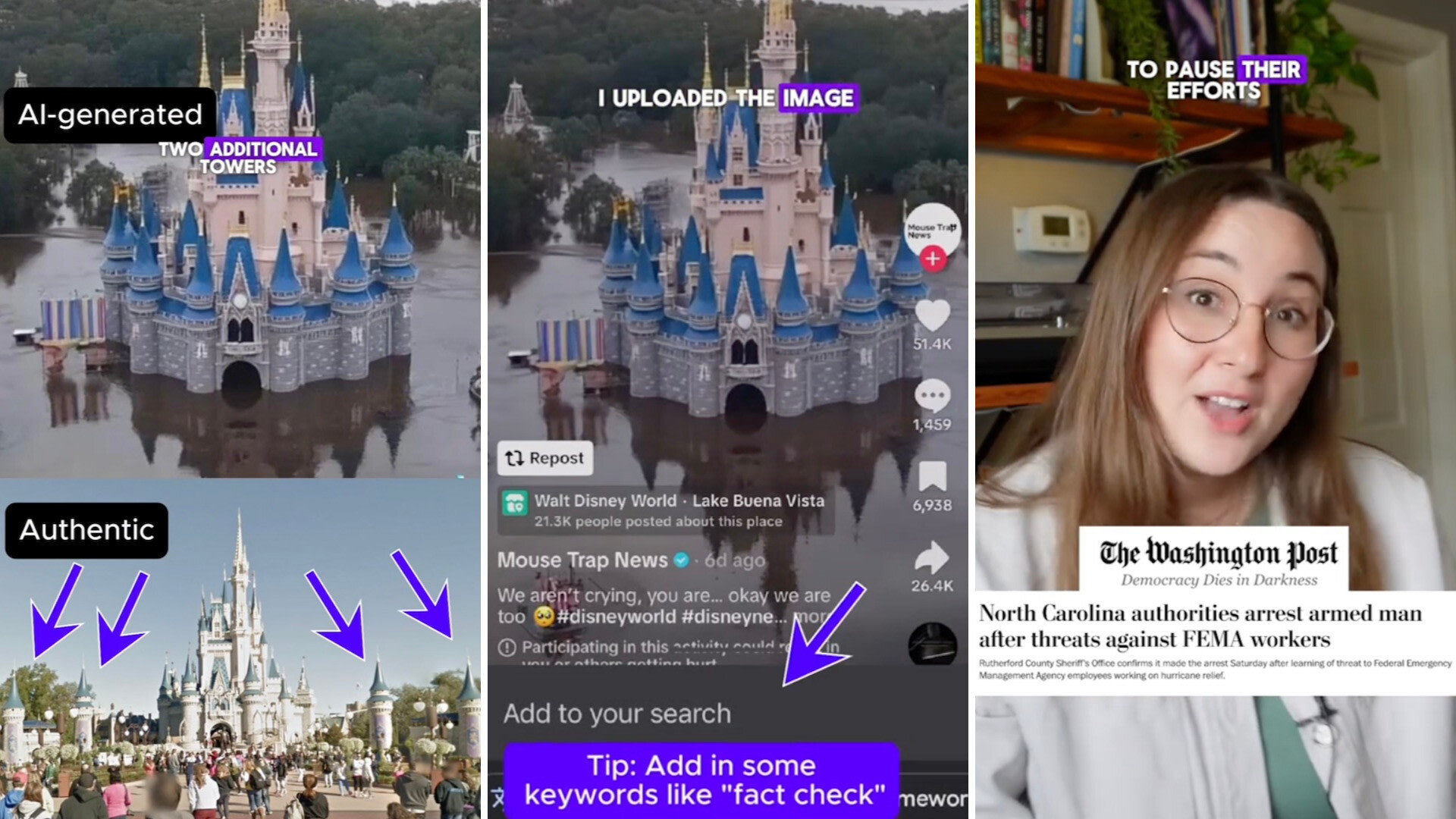A fact-checker with a nonpartisan nonprofit focused on education is revealing a new way misinformation is spreading in the modern era and highlighting how spreading unfounded rumors or conspiracy theories can put lives at risk.
In a short TikTok clip, the News Literacy Project (@newslitproject) details how images generated by artificial intelligence are making it difficult to discern what's real and what's fake. Fortunately, Alexa Volland from the News Literacy Project shows us that it's easy for people to investigate the information.
"You might have come across this image of a flooded Cinderella's Castle at Magic Kingdom that was shared after Hurricane Milton. It's AI-generated," the fact-checker begins. She added that the account sharing the photo often publishes fake information about Disney — a dead giveaway that the picture was likely not credible.
"But let's say you didn't look at their bio," she continues. "Here's how you can fact-check things like this: Compare the image to other photographs that you know are real."
Alexa proceeds to show key differences between the AI-generated photo and ones she knows are real, like one uploaded to Google Maps.
@newslitproject ❌ No, Cinderella Castle wasn't destroyed by Hurricane Milton. ✅ Multiple sources have reported that several different images of a flooded castle were AI-generated. Here are some tips for spotting the visual clues, but the BEST approach is to consider the surrounding context: Who is sharing the image? What are others saying? In this case, the video came from a satire site and was shared with an #AIGenerated hashtag. #DisneyWorld #HurricaneMilton #AI #FactCheck #MediaLiteracy #FEMA #NC ♬ original sound - News Literacy Project
That image reveals that the real Cinderella Castle has two more towers than seen in the AI image, as well as the iconic statue of Walt Disney and Mickey Mouse upfront. Other techniques to investigate whether a photograph is AI-generated include a reverse image search.
There are some methods the pros don't reveal to avoid giving away too many tips to forgers on how to avoid detection, and it's always possible that tips like these may not help to identify a more well-executed fake. But in most cases, those generating AI fakes are not able or willing to go the extra mile.
The biggest thing, in all cases, is to keep a high level of skepticism and scrutiny on any image or piece of information. This is especially true if it raises an eyebrow or comes from somewhere other than a credible source that employs professional journalists and fact-checkers like the one who made this video.
While Alexa acknowledged a fake Disney World photo may seem "inconsequential," she showcased why learning how to sift through information is crucial.
🗣️ Do you think misinformation is a major problem in America today?
🔘 Definitely 💯
🔘 Only for some people 😒
🔘 Only with certain issues 🤔
🔘 Not really 🙅
🗳️ Click your choice to see results and speak your mind
"Let's talk about misinformation that is actually dangerous," she continues, sharing screenshots of reports detailing how swirling conspiracies can lead to death threats and the halting of rescue and recovery operations — as was the case following Hurricane Helene.
According to The Washington Post, the Federal Emergency Management Agency put some of its efforts on pause after workers were subjected to harassment. The New York Times also reported on harassment, which included antisemitic and misogynistic threats, when an unfounded conspiracy theory began spreading that workers were stealing money intended for recovery at home to send to Ukraine.
In North Carolina, where more than 100 people died after the remnants of Hurricane Helene swept through the state, authorities arrested an armed man who threatened FEMA employees.
The Times also reported that one meteorologist was baselessly accused of helping the United States government manipulate a hurricane, while another received death threats.
"Murdering meteorologists won't stop hurricanes," WLNS forecaster Katie Nickolaou (@weather_katie) wrote on X, formerly Twitter. "I can't believe I just had to type that."
While many are understandably searching for answers as events like hurricanes are growing more severe, the scientific consensus — based on more than 100 years of evidence, per NASA — is that a warming climate is to blame for the extreme weather, with rising temperatures mostly caused by pollution from dirty fuels such as gas, oil, and coal.
"Unfortunately, when it comes to falsehoods, repetition is very powerful," the News Literacy Project fact-checker concludes. "The more someone hears a claim, even if it's been debunked, the easier it becomes to believe. So no matter the claim, take some time to look into it."
Join our free newsletter for weekly updates on the latest innovations improving our lives and shaping our future, and don't miss this cool list of easy ways to help yourself while helping the planet.









